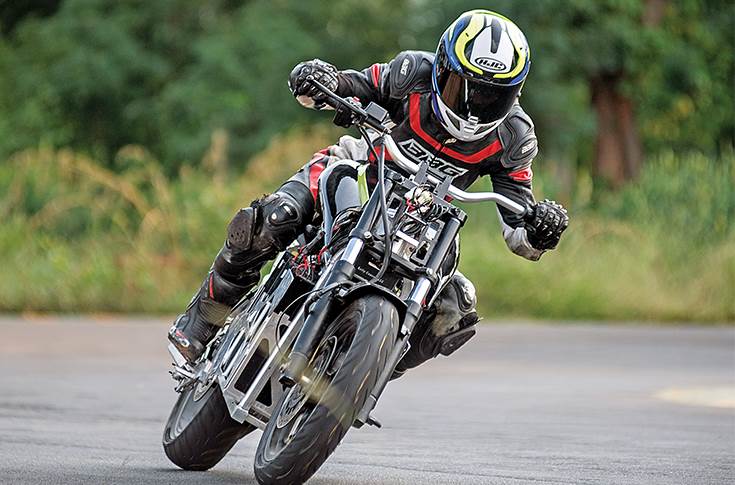Prajwal Sabnis and Ranjita Ravi, co-founders of the Bangalore-based start-up Orxa Energies, speak about their in-house designed and developed e-motorcycle, Mantis, which employs battery swapping technology, is likely to be priced at par with performance IC-engined motorcycles.
Will the Mantis be able to hold its own as established industry majors get on the e-motorcycle bandwagon? How do Orxa Energies’ founders plan to tackle competition, performance and affordability? Here’s what they have to say.
On Mantis versus Ultraviolette F77
The two bikes are completely different. This will become obvious when we unveil the production-ready prototypes at India Bike Week in early December 2019. The Mantis is a naked street sports bike, designed with a focus on range and a seamless ride experience. We have approached the vehicle architecture ground-up with keen interest in exploring alternate materials and manufacturing methods. So, our vehicle architecture is visibly different. While the Mantis is connected in the contemporary sense, one of our main drivers has been to not bombard the rider with ‘more-connectedness’ in this already hyper-connected world.

Orxa Energies claims the Mantis has a top speed of 140kph and range of nearly 200km on a single charge
Balancing price, bookings and volume
We will be revealing tentative pricing at the IBW. But since the Mantis is a naked sports motorcycle, we will be looking at a pricing similar to top performance ICE motorcycles. The feedback from regular riders as well as professional and semi-professional riders after the Mantis Performance Preview was splendid. They all called it a great street bike, perfect with the weight balance, easy to lean and throw — a great street motorcycle. In fact, some professional riders gave us a few pointers that could help make the bike even better, like minor changes to the riding position.

Prajwal Sabnis: ‘Our focus on range and on battery life was one of the driving factors for the choice of six modules over fewer modules.’
The objective of the preview, which saw over 150 people ride the Mantis for multiple laps around a technical track, was to obtain feedback on the product.
Betting on Bangalore
Orxa will first be launched commercially in Bangalore, which has a conducive environment for an EV hardware start-up. What’s more, there’s also the heritage aerospace industry here, which makes finding vendors for highly precise manufacturing easier — whether traditional manufacturing or more modern rapid prototyping/3D printing.
Secondly, the talent and ecosystem are important factors for a growing start-up. Building EVs from scratch requires not just mechanical systems but also strong expertise in electronics, embedded systems, electrical and software engineering.
There is also a strong push from the state of Karnataka on electronics and ESDM (Electronics System Design and Manufacturing) here. Karnataka was the first state in India to launch an EV policy in 2017. Even the pioneer in the Indian EV industry, the Reva, now Mahindra Electric, is based in Bangalore. Many deep technology and hardware-heavy EV start-ups are also located here for these very reasons.

Ranjita Ravi: ‘We do not want to overwhelm the rider with over-connectedness. The Mantis aims to bring back the pleasure of riding.’
Since the Mantis is a performance naked sports bike, we will target cities with strong biking cultures as well.
Modular Mantis batteries
Modularity in engineering is a well-proven concept with a vast number of advantages. Our focus on range and on battery life was one of the driving factors for the choice of six modules over fewer modules. Modularity has several advantages — even downstream for maintenance and serviceability.
Lastly, our modular, stackable swap-ready battery packs also play into our future swap network. We don’t want to have one large monolithic pack. We are strong advocates of battery swapping. More modules help with longer range and better life of the packs. The modularity allows the vehicle to perform at peak performance levels, even with four packs.

Orxa Energies founders Ranjita Ravi (seen here with the Mantis), Prajwal Sabnis and Amrudesh Santhanam and their team. The electric bike will use a six-module stack of swappable batteries
The vehicle will, in principle, run on a single pack but this is not the idea we have for the Mantis. Our battery packs are stackable and swappable, which ties into Orxa’s future plans.
Power compensates for lower level of connectivity
We stay true to the spirit of motorcycling. Of course, the Mantis will be connected and there will be a companion app with essential features including analytics, navigation and maintenance. But we do not want to overwhelm the rider with ‘gadgetisation’ and over-connectedness. The Mantis will not be ‘just another device or gadget to charge’. The Mantis seeks to bring back the sheer pleasure and thrill of riding a motorcycle.
(This interview was first featured in the December 1, 2019 issue of Autocar Professional)
/interview/prajwal-sabnis-and-ranjita-ravi-‘electric-motorcycle-mantis-will-stay-true-to-the-spirit-of-motorcycling’-45086 Prajwal Sabnis and Ranjita Ravi: ‘Electric motorcycle Mantis will stay true to the spirit of motorcycling’ Bangalore-based start-up Orxa Energies unveiled its e-motorcycle, the Mantis, at the India Bike Week 2019. https://www.autocarpro.in/Utils/ImageResizer.ashx?n=https://www.autocarpro.in/userfiles/b588e881-7e31-4948-93df-0d22643911f8.png
